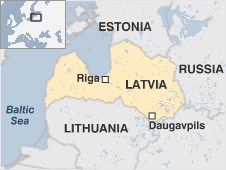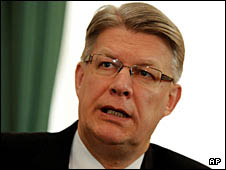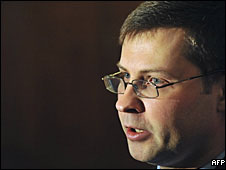 |
Situated in north-eastern Europe with a coastline along the Baltic Sea Latvia is geographically the middle of the three former Soviet Baltic republics.
It has language links with Lithuania to the south and historical and
ecumenical ties with Estonia to the north.
Overview
Not much more than a decade after it declared independence following the collapse of the USSR Latvia was welcomed as an EU member in May 2004. The move came just weeks after it joined Nato. These developments would have been extremely hard to imagine in not-so-distant Soviet times.

Riga: Eclectic capital is on Unesco's heritage list
|
For centuries Latvia was primarily an agricultural country with seafaring fishing and forestry as other important factors in its economy.
Latvia was under foreign dominion from the 13th until the 20th century. After the first world war it declared independence which Russia recognised in 1920.
Two decades later following a pact between Stalin and Hitler Soviet troops invaded in 1940 and Latvia was absorbed into the Soviet Union. Nazi forces pushed the Soviets back in 1941 but the Red Army returned in 1944 and
remained for half a century.
During the Soviet period which ended in 1991 Latvia underwent heavy industrialisation and experienced a big influx of immigrants from other
parts of the USSR mainly Russia.
About a quarter of the population is Russian-speaking and the rights of this section of society have been a thorny issue since independence. Government reforms introduced in 2004 to restrict the use of the Russian language in schools remain controversial.
Legislation on citizenship was toughened up in 2006. Candidates who fail a Latvian language test three times will be denied citizenship. People without citizenship are entitled neither to vote nor to obtain an EU passport.
Like its Baltic neighbours in the 10 years since independence Latvia made a rapid transformation to embrace the free market.
Latvia's economy grew by 50% between 2004 and 2007 but the global financial crisis of 2008 hit the country hard. An economic contraction of 12% and a 50% increase in unemployment was predicted for 2009 and the government was prompted to seek aid from the International Monetary Fund (IMF).
The social turmoil triggered by the financial crisis led to the fall of the government in February 2009.
Facts
- Full name:Republic of Latvia
- Population: 2.2 million (UN 2009)
- Capital: Riga
- Area: 64589 sq km (24938 sq miles)
- Major languages: Latvian Russian
- Major religion: Christianity
- Life expectancy: 67 years (men) 77 years (women) (UN)
- Monetary unit: 1 lats = 100 santims
- Main exports: Timber and wood products fish and fish products
- GNI per capita: US $11860 (World Bank 2008)
- Internet domain: .lv
- International dialling code: + 371
Leaders
President: Valdis Zatlers
 |
An orthopedic surgeon who took part in clearing up the consequences of the Chernobyl nuclear accident in 1986 Valdis Zatlers was born in 1955 and became active in the pro-independence Popular Front under Soviet rule in 1988.
He later scaled down his political activity to concentrate on medical work. Parliament elected him president on the nomination of the centre-right governing coalition in 2007.
Prime minister: Valdis Dombrovskis
Valdis Dombrovskis leads a six-party coalition that was approved by parliament in March 2009. Mr Dombrovskis succeeded Ivars Godmanis who resigned in February after protests at his handling of the economic crisis.
 |
A member of the European Parliament from the main centre-right New Era opposition party Mr Dombrovskis has assembled a coalition including some parties from the Godmanis government plus a smaller centre-right party the Civic Union.
With the economy expected to contract by more than 18% in 2009 his government pledged to introduce economic recovery measures.
In July his government agreed a series of deep public spending cuts with unions and employers to rescue the state from bankruptcy including a 20% reduction in public sector pay.
Born in 1971 and a physicist by training he was an MP and finance minister in 2002-2004.
Media
Latvia's TV market is dominated by the commercial LNT two networks operated by the national public broadcaster commercial TV3 Latvia and the Baltic variants of the main Russian networks. Public radio and TV are financed by state subsidies and advertising.
The media operate freely with few legal restrictions. A law provides prison terms for libel and incitement of racial hatred. Around 140 newspaper titles reflect a variety of political views.
By March 2008 around 1.3 million Latvians were online (Internetworldstats).
The press
- Diena - daily
- Neatkariga Rita Avize (NRA) - broadsheet in Latvian
- Dienas Bizness - business tabloid in Latvian affiliated to Diena
- Telegraf - main Russian-language daily
- Latvijas Avize - tabloid daily
- Chas - Russian-language daily
- Biznes & Baltiya - business broadsheet in Russian
- Vesti Segodnya - Russian-language daily
- Vakara Avize Vakara Zinas - evening tabloid in Latvian
Television
- Latvian Television (LTV) - public operates LTV1 and LTV7
- Latvian Independent Television (LNT) - main terrestrial commercial TV
- TV3 Latvia - commercial
- TV5 - commercial
Radio
- Latvian Radio - public; four national networks
- Radio SWH - commercial
- Star FM - commercial
- Radio NABA - public/university
- Radio Skonto - commercial
News agencies
- LETA - English-language pages
- BNS (Baltic News Service)
-
Delfi - news portal in Latvian and Russian
AFRICA | ASIA-PACIFIC | AMERICAS | EUROPE | MIDDLEEAST | SOUTHASIA
Mauritania Mauritius Morocco Mozambique Namibia Niger Nigeria Republic-of-congo Rwanda Sao-tome-and-principe Senegal Seychelles Sierra-leone Somalia South-africa Sudan Swaziland Tanzania The-gambia Togo Tunisia Uganda zambia Zimbabwe Australia Brunei Burma Cambodia China East-timor Fiji Indonesia Japan Kazakhstan Kiribati Kyrgyzstan Laos Malaysia Marshall-islands Micronesia Mongolia Nauru New-zealand North-korea Palau Papua-new-guinea Samoa Singapore Solomon-islands South-korea Taiwan Tajikistan Thailand The-philippines Tonga Turkmenistan Tuvalu Uzbekistan Vanuatu Vietnam Antigua-and-barbuda Argentina Bahamas Barbados Belize Bolivia Brazil Canada Chile Colombia Costa-rica Cuba Dominica Dominican-republic Ecuador El-salvador Grenada Guatemala GuyanaHaiti Honduras Jamaica Mexico Nicaragua Panama Paraguay Peru St-kitts-and-nevis St-lucia St-vincent-and-the-grenadines Suriname Trinidad-and-tobago United-states-of-america Uruguay Venezuela Albania Andorra Armenia Austria Azerbaijan Belarus Belgium Bosnia-hercegovina Bulgaria Croatia Cyprus Czech-republic Denmark Estonia Finland France Georgia Germany Greece Hungary Iceland Ireland Italy Latvia Liechtenstein Lithuania Luxembourg Macedonia Malta Moldova Monaco Montenegro Norway Poland Portugal Russia San-marino Serbia Slovakia Slovenia Spain Sweden Switzerland The-netherlands Turkey Ukraine United-kingdom Vatican Algeria Egypt Iran Iraq Israel-and-palestinian-territories Jordan Kuwait Lebanon Libya Mauritania Oman Saudi-arabia Sudan Syria Tunisia United-arab-emirates Yemen Afghanistan Bangladesh Bhutan India Nepal Pakistan Sri-Lanka The-Maldives

